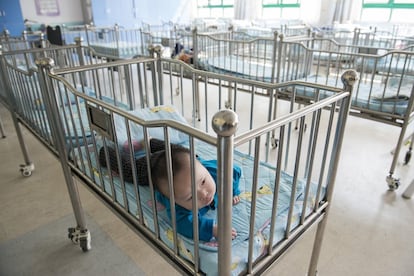China’s big challenges in 2023: a demographic crisis and job creation
Chinese policymakers are meeting this week in Beijing to set a course for the Asian giant

China’s annual plenary sessions of the National People’s Congress (known as the Two Sessions) kicked off over the weekend in Beijing with its sights set on restoring economic growth and creating jobs after three years of strict Covid-19 containment measures. The country claimed a “decisive victory” over coronavirus last month after suffering the worst infection spike of the pandemic. While the country’s output has already increased – manufacturing activity grew at the fastest pace in 11 years in February – China still faces several social challenges in 2023, including a falling birth rate, high youth unemployment and persistent problems in the housing market. Several signs of discontent have made headlines over the past few months: workers demanding pension rights and student protests calling for an end to China’s zero-Covid strategy.
According to government news sources, China’s worrisome demographic crisis will dominate the Two Sessions agenda as political leaders strive to develop a short-term roadmap for the country. The official news media portrays the meetings as a Chinese-style model of representative democracy, an attempt at dressing up an otherwise bland event that simply publicizes an agenda pre-planned by the communist hierarchy.
The current demographic crisis resulted from the high cost of raising children and decades of strict family planning policies. The government has announced proposals to provide financial aid for alleviating child-rearing expenses and eliminate the three-children-per-family policy imposed in 2021. Parents will now be able to register all newborns regardless of marital status, enabling legal recognition of the children of single mothers, unmarried couples and parents with more than three children. Also announced were post-maternity labor protections for female workers, access to assisted fertility procedures for single women, and subsidies for in-vitro fertilization and egg freezing.
In 2022, the country’s population declined for the first time in 61 years amid a historic plunge in the birth rate, a situation that increases pressure on the labor and pension systems. According to Guo Weimin, a spokesperson for the Chinese People’s Political Consultative Conference (the nation’s top advisory body), the top priority for the Two Sessions delegates is stabilizing and promoting employment.
14 million young people looking for jobs
The youth unemployment rate has been rising in recent years and reached 16.7% in December 2022. The outlook is not particularly promising since the Ministry of Education estimates that 14 million college-educated young people will be looking for work this year. Business news outlet Caixin Media estimates that only eight million of the record 11.58 million students graduating from college this summer will find jobs.
Analysts at the Trivium China policy research group believe the economy cannot grow under these demographic realities. “Every 1% of GDP growth usually generates about two million jobs, and China’s target for this year is 5% GDP growth, which translates into 10 million new jobs.” In its Government Labor Report, China claims to have created 12.06 million new urban jobs in 2022, with an urban unemployment rate of around 5.5% in December. However, experts noted that most of those jobs were temporary, offered by local governments in a year marked by mandatory confinements and massive Covid-19 testing campaigns. In 2022 alone, provincial governments spent $50.77 billion (€48 billion) to fight Covid-19, according to official budget data.
The National Development and Reform Commission (NDRC), China’s top economic planning entity, pledged to “emphasize the promotion of youth job placement” and increase unemployment compensation in 2023. The NDRC also stressed that “housing is for people to live in, not for speculative buying and selling” and claims to have made 2.65 million social housing units available for rent in 2022 to “alleviate the housing-related difficulties of new urban populations, young people and other groups.” Housing prices in the country’s most developed cities rose by 0.2% over the prior month in January. Meanwhile, 36 of the country’s 70 largest cities recorded increases in housing costs in January, compared to the 21 that reported increases in December 2022.
An aging population and shrinking labor force pose serious problems for the world’s second-largest economy, which has based its growth on a vast and inexpensive labor force for decades. China’s labor force has steadily declined since it peaked in 2014 at nearly a billion people. In July 2022, the United Nations announced that the number of working-age Chinese will not exceed 400 million by the end of this century. This will add pressure to the pension system, which offered basic coverage to 1.053 billion people as of December 2022.
China’s Ministry of Finance reported an increase of 140 million beneficiaries in its pension system. Despite overwhelming public opposition, raising the retirement age is looking more likely after 40 years of remaining stable at 60 for men and 55 for women.
Chinese retirees staged rare protests in February against cuts in their monthly medical allowances, part of a nationwide restructuring of the healthcare system. This came on the heels of the “White Paper” protests in November 2022, when hundreds of people took to the streets to demand an end to iron-fisted pandemic containment measures. That rebellion came shortly after migrant workers in Guangzhou and thousands of employees at Foxconn’s Zhengzhou factory – the world’s largest iPhone maker – clashed with police and demanded payment of their stipulated wages.
Sign up for our weekly newsletter to get more English-language news coverage from EL PAÍS USA Edition
Tu suscripción se está usando en otro dispositivo
¿Quieres añadir otro usuario a tu suscripción?
Si continúas leyendo en este dispositivo, no se podrá leer en el otro.
FlechaTu suscripción se está usando en otro dispositivo y solo puedes acceder a EL PAÍS desde un dispositivo a la vez.
Si quieres compartir tu cuenta, cambia tu suscripción a la modalidad Premium, así podrás añadir otro usuario. Cada uno accederá con su propia cuenta de email, lo que os permitirá personalizar vuestra experiencia en EL PAÍS.
¿Tienes una suscripción de empresa? Accede aquí para contratar más cuentas.
En el caso de no saber quién está usando tu cuenta, te recomendamos cambiar tu contraseña aquí.
Si decides continuar compartiendo tu cuenta, este mensaje se mostrará en tu dispositivo y en el de la otra persona que está usando tu cuenta de forma indefinida, afectando a tu experiencia de lectura. Puedes consultar aquí los términos y condiciones de la suscripción digital.
More information
Archived In
Últimas noticias
Most viewed
- Reinhard Genzel, Nobel laureate in physics: ‘One-minute videos will never give you the truth’
- Oona Chaplin: ‘I told James Cameron that I was living in a treehouse and starting a permaculture project with a friend’
- Pablo Escobar’s hippos: A serious environmental problem, 40 years on
- Why we lost the habit of sleeping in two segments and how that changed our sense of time
- Chevy Chase, the beloved comedian who was a monster off camera: ‘Not everyone hated him, just the people who’ve worked with him’











































